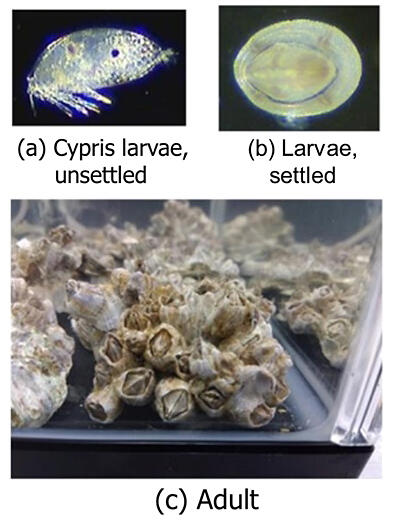A research group led by Associate Professor Hiroyoshi Takamura and Professor Isao Kadota of the Faculty of Environmental, Life, Natural Science and Technology and Assistant Professor Kenta Tanaka of the Research Institute for Interdisciplinary Science at Okayama University, in collaboration with Associate Professor Takefumi Yorisue of the Institute of Natural and Environmental Sciences at the University of Hyogo, has discovered that the organic compound xylemin has an inhibitory effect against the settlement of barnacles.
Takamura said, "I was honestly surprised that such a small compound effectively inhibited the settlement of barnacles. Moving forward, I will work on developing antifouling paints, hoping to contribute to solving the problem of biofouling."
The study was published in Chemistry & Biodiversity.

Provided by Okayama University
Sessile organisms such as barnacles are called fouling organisms because they cause a great deal of damage to the marine industry. The settlement of sessile organisms on the ship's bottom surfaces dramatically lowers the fuel economy, resulting in a serious economic loss. Moreover, sessile organisms can settle on and block seawater pipelines in coastal power plants, decreasing the efficiency of heat exchange and cooling systems.
Currently, several compounds that inhibit the settlement of organisms are in use, but their adverse effects on the environment, such as toxicity to organisms, have been reported, raising concerns. This means that there is a strong need to develop new settlement inhibitors that are effective, safe, and biologically and environmentally friendly.
The cypris larvae of barnacles engage in exploratory behavior to find places for settlement and transform into juveniles after the settlement and metamorphosis. Once settled, the larvae of barnacles live there for the rest of their lives, growing to adulthood. The research group used the organic compound xylemin and its related compounds, which they had synthesized previously, to evaluate their settlement-inhibitory activity and toxicity on cypris larvae of the barnacle Amphibalanus amphitrite.
As a result, they found that xylemin and one of its analogs effectively inhibited the larval settlement with 50% effective concentrations of 4.25 and 6.11 micrograms/milliliter, respectively. Moreover, both compounds showed no toxicity even at a concentration of 50 micrograms/milliliter. Although several settlement inhibitors have been commercialized, most are biocidal antifouling agents, and their environmental impact has been a concern. Thus, the research and development of settlement inhibitors from nontoxic organic compounds is attracting attention. Moving forward, new antifouling paints that are effective, safe, and biologically and environmentally friendly are expected to be developed based on xylemin and its related compounds.
Journal Information
Publication: Chemistry & Biodiversity
Title: Antifouling Activity of Xylemin, Its Structural Analogs, and Related Polyamines
DOI: 10.1002/cbdv.202403213
This article has been translated by JST with permission from The Science News Ltd. (https://sci-news.co.jp/). Unauthorized reproduction of the article and photographs is prohibited.




